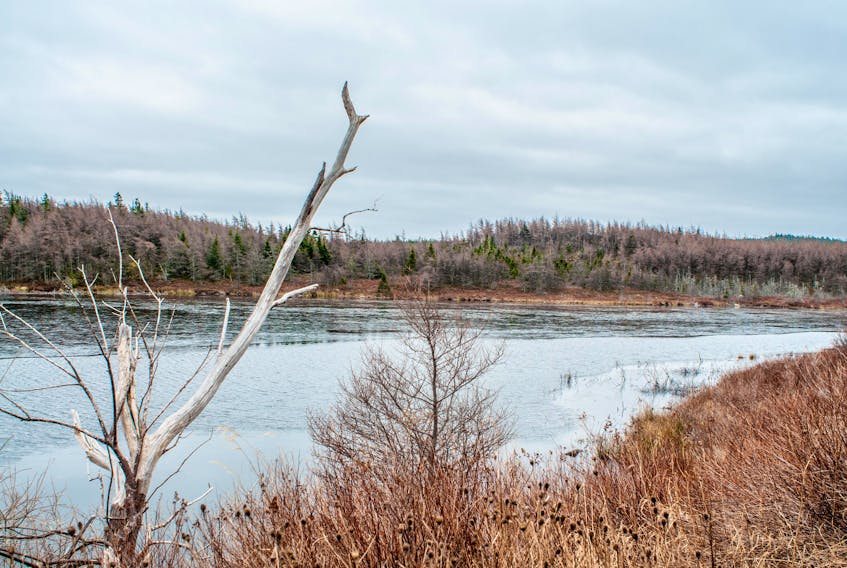It is going to be a very short winter here on the Avalon Peninsula. At least that’s what I think.
There’s no real winter weather in the long range forecast up to past the middle of January. Last year this time many folks were already sick of Jack Frost. For my part I don’t mind winter at all, come what may.
My philosophy is one of adaptation and making the best of whatever the gods send along. You might say “play the cards you are dealt,” I suppose.
If the snow and deep freeze comes at all, I have high hopes of cutting a few cords of spruce firewood in the country up past the western extreme of Spider Pond. That’s traditionally wood cutting country, following the horse and slide paths of days long gone.
I also have notions of cutting some 24-foot long spruce boat plank sticks. Robert says he knows where to find them, but that will only happen if solid ice forms soon. It is not looking good right now.

What do I want with boat plank? Well, that’s another story, but I have bargained for a 5-HP Atlantic Marine Gas Engine. The engine is residing in Nova Scotia right now and I will be taking possession this summer if all goes well. If it weren’t for COVID-19 the engine would be sitting in my garage right now.
I see a motorboat in my future.
Besides wood harvesting, there’s lots of other fun stuff to do in the snow.
Trekking on snowshoes you know is a passion of mine. This winter I want to try out a new lightweight metal stove on a hot-tenting expedition.
That plan is looking gloomy as well.
I have not used my racquets at all yet. I have plowed snow just once and if I had waited 24 hours it would have bloody been all melted. I just don’t know how our ancestors could have survived winters like this one is shaping up to be. They needed the ice cover to gather firewood and building materials for fences, stages, barns and houses.
My father was born in 1912 and lived the winter wood-cutting life for many seasons. I cannot recall him mentioning a winter with Spider Pond not frozen safely. I have seen more than a few in just the last 10 years.
I might have to settle for a few loads of fir cut on trails off the road to Spider Pond. It will burn, but not with the same intensity and longevity as spruce. I love tall straight spruce with just dry twigs up ten feet, and a green bush at the top. I’m thinking wood harvesting heaven.
You won’t access that around these parts without ice cover.
And you know what, there’s always winter fly fishing, best pursued in mild rainy winters. This could be a bumper year.
Right now, it’s not looking good for conventional ice fishing. February first is really not that distant and I might go for a kayak paddle tomorrow evening if the wind drops out.
It will be fly fishing come February I’m thinking. I’ll have my bead headed nymphs all tied up and ready for action.
This got me to thinking. Fly fishing has evolved and changed so much since I started and got my first long rod for passing Grade 2 in 1967.
I think Dad called it a salmon rod, but we also used them for trouting. The sport nowadays is really a very deep complex rabbit hole. I would never have dreamed as a kid that I’d be fly fishing rivers, streams and estuaries in the middle of winter. But yes indeed, I have and will again.
Grant you skeptics, this is a quite specialized form of angling far removed from the quintessential image that most folks have of angling with fur, tinsel and feather. That’s the “A River Runs Through it” Brad Pitt sort of imagery. The flies are very different, but I’ll spare you the gear detail and move to the actual technique.
How might one go about fly fishing a stream in winter?
Well, I got to tell you flat out; you won’t catch much floating a bug or dry fly like the brothers and father in the movie.
In winter there isn’t much insect life on the surface and trout are conditioned not to even both with looking. They tend to be lethargic and not move far from their lazy feeding and resting places. They prefer an ambush strategy.
But they definitely need to eat something, and they will likely not refuse an aquatic insect drifted past their nose.
That’s the secret. Present the offering of winter like food right in front of them so they can just open wide and indulge. Think like a winter trout. Where would you be resting and hiding in ambush? Read the currents and flows.
So, you have to sink the fly to the depth of the trout. Sure, that’s not fly fishing, many will say. I think it is and in many ways is more exciting and challenging than two-dimensional surface fishing.

We are now fishing in 3D, and blind at that, because you have to find the right depth by trial, error and intuition. This is serious strategic angling and lots of fun.
I’ll guide you through a typical winter stream scenario. The river is 14-ft wide and flows chaotically around rocks and protruding cliff. There are deep pools of smoother flat water interspersed with the turbulence. There will be trout I think, close to the bottom, resting and waiting for drifting aquatic life, just downstream of the white water. I kneel in the snow on the bank, so the trout don’t see my long shadow.
They aren’t dumb even in the depths of winter.
There is no need for long fancy casts. Save that for the big salmon rivers. I tie on a weighted fly and sort of toss 12 or so feet of line upstream. As the fly begins its drift in the current I lift my rod to control and maintain what I think is the right depth. I have a colour-coded leader section to help me judge the depth. It also helps me detect subtle strikes.

If the line shows any unnatural motion lift the rod to set the hook. So, you toss or flip cast upstream and lift the rod skyward to a maximum as the fly passes in front of you, then dropping the rod tip to maintain depth as the fly continues down current to the dangle. You should end up with a constant depth drift. This technique takes a bit of practice, but it really works. And wait a few seconds before recasting because trout will sometimes follow and grab on the dangle.
Or you could cheat and use a tiny cork bobber, excuse me a fly fishing strike indicator.
Yes indeed, that’s what they call them. Norman Maclean would be horrified. They were bobbers when I was a kid and they are still bobbers. Some folks use a strand of poly yarn. I suppose that’s a strike indicator. Maybe you will fancy giving this a try if the ponds aren’t safe.
And if you have a few hours to spare watch “The Movie.” It’s so iconic in the fly-fishing world that we call it just that. “A River Runs Through it” is now on Netflix.
Paul Smith, a native of Spaniard’s Bay, fishes and wanders the outdoors at every opportunity.









